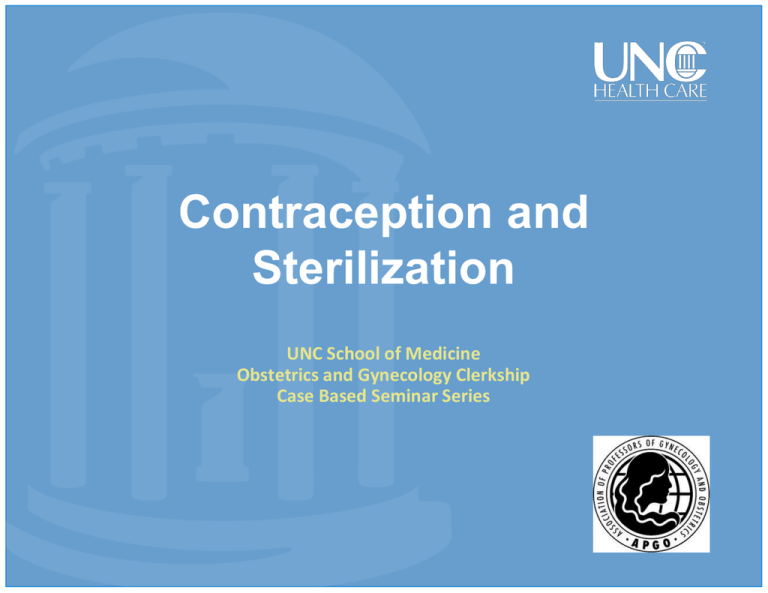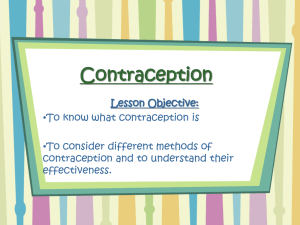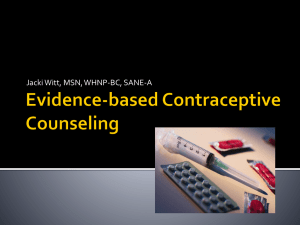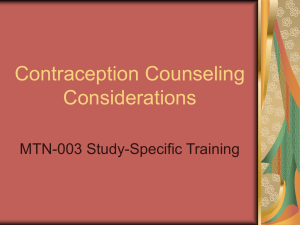
Contraception and
Sterilization
UNC School of Medicine
Obstetrics and Gynecology Clerkship
Case Based Seminar Series
Objectives for Contraception and Sterilization
Describe the mechanism of action and effectiveness of
contraceptive methods
Counsel the patient regarding the benefits, risks, and use
for each contraceptive method
Describe barriers to effective contraceptive use and to the
reduction of unintended pregnancy
Describe the methods of male and female surgical
sterilization
List the risks and benefits of female surgical sterilization
procedures
2
Contraception is important because unintended
pregnancy in the U.S. is common
• 6.3 million pregnancies
Unintended
Intended
22%
51%
49%
Birth 22%
20% Abortion 20%
7%
Fetal Loss 7%
3
Current contraceptive Methods available in the US
Most
effective
Prevents
pregnancy
>99% of the
time
Male/Female
Sterilization
IUD/IUS
Implants
Very
effective
Prevents
pregnancy
~91-99% of
the time
Pills
Injectables
Patch
Ring
Moderately
effective
Effective
Prevents
pregnancy
~81-90% of
the time
Prevents
pregnancy
up to 80% of
the time
Male/Female
Condom
Sponge
Diaphragm
Fertility
awareness
Cervical cap
Spermicide
4
Distribution of contraception use by women
in the US
% of US women 15-44 years
25
22.8
20
17.3
15
10
10
5
2
3.2
3.4
0.8
2.2
0
Mosher, et al. 2010.
5
Unintended Pregnancy and
Contraceptive Use
Consistent use,
method failed,
5%
Inconsistent or
incorrect use, 43%
Nonuse,
52%
3.1 million unintended pregnancies,
by women's contraceptive use during month of conception
Frost JJ, Darroch JE, Remez L. In Brief. 2008.
6
Direct counseling to focus on effectiveness
http://www.fhi.org/nr/shared/enFHI/Resources/EffectivenessChart.pdf
7
Resources for contraceptive counseling and
prescribing
Evidence based guidance for the use of contraception
with health conditions
U.S. Medical Eligibility Criteria
http://www.cdc.gov/mmwr/pdf/rr/rr59e0528.pdf
8
USMEC Definitions
Category
Definition
1
A condition for which there is no restriction for the use of the
contraceptive method
2
A condition for which there is no restriction for the use of the
contraceptive method
3
A condition for which the theoretical or proven risks usually outweigh
the advantages of using the method
4
A condition for which the theoretical or proven risks usually outweigh
the advantages of using the method
http://www.cdc.gov/mmwr/pdf/rr/rr59e0528.pdf
9
Using USMEC; (e.g. for hypertension)
Pages 12-13 for HTN with combined oral
contraceptives
Risks generally outweigh the benefits and alternative methods
exist
Increased risk of stroke among women with HTN and on COC’s
compared to women not on COC’s
P 35-36 for HTN and progestin contraceptives
Benefits generally outweigh the risks
P.53 for HTN and IUC
Benefits outweigh the risks
10
Cost
• Basically all are remarkably similar
• Implants and intrauterine contraceptive most
cost effective
• Hormonal contraception – about $30$40/month ($360-$480 per year)
• Mirena® - $750/7 years ($108/year)
• Cu-T380a IIUD - @$600/12 yrs ($50/year)
11
Current Contraceptive Options
Most
effective
Prevents
pregnancy
>99% of the
time
Male/Female
Sterilization
IUD/IUS
Implants
Moderately
effective
Effective
Prevents
pregnancy
~91-99% of
the time
Prevents
pregnancy
~81-90% of
the time
Prevents
pregnancy up
to 80% of the
time
Pills
Injectables
Patch
Ring
Male/Female
Condom
Sponge
Diaphragm
Fertility
awareness
Cervical cap
Spermicide
Very effective
12
Male sterilization
(permanent contraception)
Most
effective
Prevents
pregnancy
>99% of the
time
Male
Sterilization
•Vasectomy
•Failure rate 5/1000 in first year of use
•0.1 – 0.15 in first year
•Absence of sperm should be documented
•Cost about $200
13
Male sterilization
(permanent contraception)
Most
effective
Prevents
pregnancy
>99% of the
time
Male
Sterilization
• Surgeons who do more than 10/year
have lower complication rates
• Successfully reversed only 50% of time
• Rare side effects
–
Hematomas and infection
• No increased risk of prostate or testis
cancer
• No adverse health consequences
14
Female sterilization
Methods
Most
effective
Prevents
pregnancy
>99% of the
time
Female
Sterilization
• Laparoscopy
– Coagulation
– Filschie clips
• Minilaparotomy
• Postpartum
• Used by 27% of couples in US
15
Female sterilization
Benefits and Risks
Most
effective
Prevents
pregnancy
>99% of the
time
Female
Sterilization
• Mortality lower than
childbearing (1.5/100,000
compared to 8/100,000)
• Failure rate 0.2 -0.4 per 100
women in first year
• Cost about $2000
16
Levonorgestrel Intrauterine System
(LNG IUS)
Most
effective
Prevents
pregnancy
>99% of the
time
IUD/IUS
17
Levonorgestrel Intrauterine System
(LNG IUS)
Brand name: Mirena®
20 mcg levonorgestrel/day
Approved for 5 years use, evidence
supports use up to 7 years
Decreased menstrual bleeding in 80%
users by 1 year
Amenorrhea in ~20% of users by 1 year
18
LNG IUS
Mechanism of action
Progestin results in decreased tubal
motility)
Thickened cervical mucus
Endometrium becomes decidualized
with atrophy of the glands
Cycles are ovulatory in 50-75% of
women
19
LNG IUS
Benefits and Risks
Decreases menstrual blood loss by 40-50%
Decreases amenorrhea
Can treat and prevent endometrial hyperplasia
One of the most effective methods
“Forgettable”
Rapidly reversed upon removal
5% risk of expulsion in first year
1/1000 risk of perforation at insertion
<1/1000 risk of infection in first 20 days after
insertion
20
Levonorgestrel Intrauterine System
Contraindications
Contraindications – all are relative, and
involve counseling of risks vs. benefits
Prior ectopic (progestin results in
decreased tubal motility)
Active cervical or reproductive organ
infection
Undiagnosed abnormal uterine
bleeding
21
Copper-T IUD
Most
effective
Prevents
pregnancy
>99% of the
time
ParaGard®
Copper T-380a
Labeled for 10 years of
continuous use
Evidence supports use up to
12 years continuous use
Cu-T380a IUD
22
Copper-T IUD
Mechanism of action
Copper induces a
spermicidal environment in
the uterus
23
Copper-T IUD
Benefits and risks
“Forgettable” contraception
Lasts for 12 years
Highly effective
May cause slightly heavier menses in the
first three months of use
Expulsion up to 5% in the first year
1/1000 risk of perforation at time of
insertion
24
Copper-T IUD
Contraindications
VERY FEW
Wilson’s Disease
Active cervical or pelvic infection
25
Intrauterine contraception (IUC)
Busting myths and misconceptions
Can be used in nulliparous women
Can be used in adolescents
Can be used for 7-12 continuous years (method
dependent)
Can be placed without waiting for a GC/Chl screen
result
26
Intrauterine contraception (IUC)
Busting myths and misconceptions
Can be used in a woman with a history of pelvic
inflammatory disease
No antibiotics required at placement
An STI or PID with IUC in place doesn’t require IUC
removal for treatment
27
Subdermal Implant
Most
effective
Prevents
pregnancy
>99% of the
time
Brand name: Implanon®
Releases 60 mcg etonogestrel
per day
Effective for 3 years
Implants
Implanon insert: Diaz S., Contraception, 2002: Trussel J, Contraceptive Technology, 2007 Croxatto HB, Contraception, 1998; Diaz S,
28
Contraception, 2002; Funk S, Contraception, 2005. Implanon Prescribing Information. et al.
Subdermal Implant
Mechanism of action
Ovulation suppression
Implanon insert: Diaz S., Contraception, 2002: Trussel J, Contraceptive Technology, 2007 Croxatto HB, Contraception, 1998; Diaz S,
29
Contraception, 2002; Funk S, Contraception, 2005. Implanon Prescribing Information. et al.
Subdermal Implant
Benefits and risks
“Forgettable”
Rapidly reversible upon removal
Decreased menstrual bleeding
Good for persons who don’t want
something in their uterus
Unpredictable vaginal bleeding for
duration of use
Menstrual bleeding is highly variable
30
Subdermal Implant
Contraindications
Some antiepileptic drugs
Inability to manage irregular
and unpredictable menses
31
Depot Medroxyprogesterone Acetate
(DMPA)
Very effective
Brand name: Depo-Provera®
Intramuscular or subcutaneous
injection every 13 weeks
Prevents
pregnancy
~91-99% of
the time
Injectables
Trussel J. Contraceptive Technology. 2007. Cromer BA. Am J Obstet Gynecol. 2005. Trussel J. Contraception. 2004.; Westhoff C.
Contraception. 2003. et al.
32
Injectable
Mechanism of action
Very effective
Prevents
pregnancy
~91-99% of
the time
Thickens cervical mucus so it
becomes impervious to
sperm
Ovulation suppression
Makes the endometrium
inhospitable to ovum
Injectables
33
Injectable
Benefits and risks
Very effective
Prevents
pregnancy
~91-99% of
the time
Injectables
Redose every three months
Only 6 failures per 100 women in the first year of
use
Irregular bleeding for first 3-6 months
Amenorrhea after 6 months of use
Not associated with long term bone loss
Encourage women to eat healthy and be active
to help avoid weight gain.
Consider future fertility plans – can take up to 18
months for regular monthly menses to resume.
34
DMPA
Contraindications
Very effective
Prevents
pregnancy
~91-99% of
the time
Injectables
Minimal
Inability to manage irregular and
unpredictable menses in first 6 months
of use
Inability to tolerate amenorrhea
Desire to become pregnant within two
years
Severe coagulation disorders
History of sex hormone induced liver
adenoma
35
Special consideration
DMPA and bone loss
The medical literature demonstrates that bone mineral density
(BMD) loss associated with DMPA is substantially reversed after
discontinuation in premenopausal women after DMPA treatment for
up to 5 years
ACOG and WHO support long-term use of DMPA for contraception
for women 18 to 45 years old
ACOG and WHO state the advantages of DMPA likely outweigh the
theoretical and safety concerns
36
Vaginal Ring
Very effective
Brand name: NuvaRing®
Flexible, unfitted ring placed in vagina
Prevents
pregnancy
~91-99% of
the time
Can be difficult for women to start using this
method, but once they start they are pleased
with it
Leave in for 3 weeks
Can take out for longer than 3 hrs in one 24
hour period without decrease in effectiveness
Ring
NuvaRing Prescribing Information. Organon. 2001: Timmer CJ. Clin Pharmacokinet. 2000. Herndon EJ. Am Fam Physician. 2004:
Dieben TO. Obstet Gynecol. 2002: Linn ES. Int J Fertil. 2003. et al.
37
Vaginal Ring
Mechanism of action
Very effective
Prevents
pregnancy
~91-99% of
the time
Anovulation by suppressing LH
and FSH
Thickening of the cervical mucus
so impervious to sperm
Alteration of endometrial lining
so no longer receptive to ovum
Ring
38
Vaginal Ring
Benefits and risks
Very effective
Failure rate 1/100 in first year
Lasts for three weeks
Prevents
pregnancy
~91-99% of
the time
Steady state of medications
Decreased intermenstrual
bleeding compared to pills
Ring
39
Vaginal Ring
Contraindications
Very effective
Contraindicated in women who are over 35 and
smoke, who have hypertension, who have a
history of VTE
Prevents
pregnancy
~91-99% of
the time
Pharmacokinetic profile theoretically similar to
OCP, although minimal evidence to support
Theoretically there is a bypass of first pass
metabolism.
Ring
40
Combined Oral Contraceptives
Very effective
Contain estrogen & progestin
20 – 35 mcg of ethinyl estradiol
Prevents
pregnancy
~91-99% of
the time
and
One of eight synthetic progestins
Formulations
28-day
Pills
84 day
Extended (longer than three months)
Trussel J. Contraceptive Technology. 2007:Rosenberg MJ. Reprod Med. 1995: Potter L. Fam Plann Perspect. 1996; Mosher WD.
AdvanceData. 2004. Hardman JG. McGraw-Hill. 1996.: Goldzieher JW. Fertil Steril. 1971.: Moghissi KS. Fertil Steril. 1971.
41
Combined Oral Contraceptives
Mechanism of action
Very effective
Prevents
pregnancy
~91-99% of
the time
Anovulation by suppressing LH
and FSH
Thickening of the cervical mucus
so impervious to sperm
Alteration of endometrial lining so
no longer receptive to ovum
Pills
42
Combined Oral Contraceptives
Counseling
Very effective
Prevents
pregnancy
~91-99% of
the time
Pills
If using monthly dosing the most
important pill to not forget is the
first pill of anew pack
Not teratogenic
If menses are missed don’t stop
taking the pill:
Take a urine pregnancy test
Continue taking the pill as
directed
If test positive then call MD
43
Combined Oral Contraceptives
Benefits and risks
Very effective
Easy to dispense
Easy to store
Prevents
pregnancy
~91-99% of
the time
Pills
Effectiveness highly dependent upon
adherence by the user
Slight increased risk of venous
thromboembolic events – but this
risk is much lower than the risk of a
VTE in pregnancy
Trussel J. Contraceptive Technology. 2007:Rosenberg MJ. Reprod Med. 1995: Potter L. Fam Plann Perspect. 1996; Mosher WD.
AdvanceData. 2004. Hardman JG. McGraw-Hill. 1996.: Goldzieher JW. Fertil Steril. 1971.: Moghissi KS. Fertil Steril. 1971.
44
Combined Oral Contraceptives
Contraindications
Very effective
Prevents
pregnancy
~91-99% of
the time
Absolute contraindications
• Older than 35 and smoking
(increased risk of MI 11x)
• Prior history of VTE
Relative contraindications
Relative Contraindications
Pills
Migraines with aura
Hypertension
Use the MEC to guide your decision
making
45
Extended Hormonal Contraception
Delays or eliminates
menstruation
Menstrual and nonmenstrual
benefits
Extended methods:
Continuous use of COCs, transdermal patch & vaginal ring
Seasonale® , Seasonique & Lybrel - dedicated extended OC
regimen
Anderson FD. Contraception. 2003. Kaunitz AM. Contraception. 2000. ARHP. 2003. NuvaRing Product Information. 2001. Stewart FH.
46
Obstet Gynecol. 2005. Kwiecien M. Contraception. 2003. Sulak PJ. Am J Obstet Gynecol 2002.
Extended contraception
Women generally like having fewer menses
Never
Every 6 Months
Every 3 Months
Every Other Month
Every Month
40%
16%
13%
ARHP Greenberg Quinlan Rosner Survey 2005.
47
Extended Contraception
Candidates for Reduced Menstruation
Women with menstrual-related disorders or anemia
Adolescents
Perimenopausal women
Athletes
Women in the military
Developmentally delayed women
Any woman who chooses to bleed less frequently
48
Generic Contraceptives
Pharmacies may provide
different substitutions each
month
May/may not ↓ costs for
those paying out of pocket
49
Transdermal Patch
Very effective
Prevents
pregnancy
~91-99% of
the time
Brand name: OrthoEvra®
Beige-colored patch applied once per
week
Patch
Abrams LS. Fertil Steril. 2002: Ortho Evra Prescribing Information. Archer DF, et al. Fertil Steril. 2002.; Zacur HA, et al. Fertil Steril.
2002.; Zieman M, et al. Fertil Steril. 2002.; Archer DF, et al. Contraception. 2004.; Audet MC, et al. JAMA. 2001.
50
Transdermal Patch
Mechanism of action
Very effective
Prevents
pregnancy
~91-99% of
the time
Anovulation by suppressing LH
and FSH
Thickening of the cervical mucus
so impervious to sperm
Alteration of endometrial lining so
no longer receptive to ovum
Patch
Abrams LS. Fertil Steril. 2002: Ortho Evra Prescribing Information. Archer DF, et al. Fertil Steril.
2002.; Zacur HA, et al. Fertil Steril. 2002.; Zieman M, et al. Fertil Steril. 2002.; Archer DF, et al.
Contraception. 2004.; Audet MC, et al. JAMA. 2001.
51
Transdermal Patch
Benefits and risks
Very effective
Prevents
pregnancy
~91-99% of
the time
Patch
Only change once a week
May result in rash or irritation at side
of administration
Associated with higher serum levels
of estradiol however this has not
corroborated with increased risk of
VTE
Abrams LS. Fertil Steril. 2002: Ortho Evra Prescribing Information. Archer DF, et al. Fertil Steril.
2002.; Zacur HA, et al. Fertil Steril. 2002.; Zieman M, et al. Fertil Steril. 2002.; Archer DF, et al.
Contraception. 2004.; Audet MC, et al. JAMA. 2001.
52
Transdermal Patch
Contraindications
Very effective
Prevents
pregnancy
~91-99% of
the time
Increased risk of, or history of, stroke,
VTE
Hypertension
Allergy to components of the medication
Avoid in women over 35 who smoke (like
oral contraceptives)
Patch
53
Progestin-Only Oral Contraceptives
Very effective
Prevents
pregnancy
~91-99% of
the time
Called the “mini-pill”
Two formulations: norethindrone
& norgestrel
Failure rate:
<1 – 3 out of 100 women in their
first year of use
Patch
Apgar BS. AFP. 2000; WHO MEC. 2004. Contraception Report. 1999. Apgar BS. AFP. 2000. et al.
54
Progestin-Only Oral Contraceptives
Mechanism of action
Very effective
Prevents
pregnancy
~91-99% of
the time
Thickens cervical mucus so
impermeable to sperm
Decreased frequency of
ovulation, but doesn’t create
fully anovulatory state
POP
Apgar BS. AFP. 2000; WHO MEC. 2004. Contraception Report. 1999. Apgar BS. AFP. 2000. et al.
55
Progestin-Only Oral Contraceptives
Benefits and risks
Very effective
Prevents
pregnancy
~91-99% of
the time
POP
No estrogen so can be used by
women unable to take estrogen
containing contraception
Less forgiving – i.e. if a woman is
more than 4 hours late taking her
pill she should use a back up
method (condom) for 48 hours
Failure rate higher than with
combined oral contraceptives
Apgar BS. AFP. 2000; WHO MEC. 2004. Contraception Report. 1999. Apgar BS. AFP. 2000. et al.
56
Progestin-Only Oral Contraceptives
Contraindications
Very effective
Prevents
pregnancy
~91-99% of
the time
•Very few
•Severe thromboembolic disorder
•Active liver disease
POP
57
Male Condom
Composition
Latex
Polyurethane
Silicone rubber
Failure rates:
3-14% in first year of use
1-5% slippage
1-8% breakage
Emergency contraception (EC)
Hatzell T. Sex Transm Dis. 2001. Trussel J. Fam Plann Perspect 1994. Trussel J. Contraceptive Technology. 2007.
58
Male Condom
Must be used correctly and
consistently
Should always be used for the
prevention of STI’s
Hatzell T. Sex Transm Dis. 2001. Trussel J. Fam Plann Perspect 1994. Trussel J. Contraceptive Technology. 2007.
59
Female Condom
Brand name: Reality®
Failure 5-21% in first year
of use
Polyurethane
High cost and poor
acceptability are biggest
barriers
Hatzell T. Sex Transm Dis. 2001. Trussel J. Fam Plann Perspect 1994. Trussel J. Contraceptive Technology. 2007.
60
Sponge
•Failure rate 9-40%
•Higher failure in parous women
•Available over the counter
Engender Health. 2005. Trussel J. 2007.
61
Diaphragm
Not very popular
Failure rate 6-12%
Made of latex
Must be fitted by a physician
Used with a spermicide
Must be used consistently and
correctly
Fihn SD. JAMA. 1985. D’Oro LC. Genitourin Med. 1994.
Trussel J. Contraceptive Technology. 2007.
62
Fertility Awareness
Failure rate 9-24% in first year
Multiple methods:
Rhythm method
Standard days method
Brand name: CycleBeadsTM
LAM
Billings ovulation method
Symptothermal method
Arevalo M. Contraception. 2002. CycleBeads Product Information.
63
Spermicide
Failure rate 6-26% if used alone
Available as creams, gels, film,
foam, and suppositories
containing nonoxynol-9
Used alone or with a barrier
method
Roddy RE. N Engl J Med. 1998. Trussel J. Contraceptive Technology. 2007.
64
Emergency contraception
“The condom broke last night”
65
EC Available in the United States
Combined Pills
Progestin-only
Pills
Copper-T IUD
Dedicated Products:
®
Plan B
®
Ella
Trussell J, Raymond EG. 2007.
66
Emergency Contraceptive
Dedicated products
®
0.75mg levonorgestrel (Plan B )
2 pills
Take 1st dose within 120 hours s/p intercourse (FDA-approved
for only 96 hours s/p intercourse), 2nd dose 12 hours later
Or take both pills at the same time (within 120 hours s/p
intercourse) -> more side effects
Effectiveness decreases over time
30mg ulipristal acetate x 1 (Ella)
1 pill within 120h s/p intercourse
selective progesterone receptor modulator
Effectiveness maintained through five days
Both prevent ovulation and thin the endometrium
Trussell J, Raymond EG. 2007.
Faculty of Sexual and Repro Health New Product Review, 2009.
67
Emergency Contraceptive Pills
Using Ordinary OCP’s
Ordinary oral contraceptive pills containing both
estrogen and progestin
Pill
Plan-B
Ovral
Lo/Ovral
Seasonal
Triphasil
Alesse
Pills per dose
1 white pill
2 white pills
4 white pills
4 pink pills
4 yellow pills
5 pink pills
Trussell J, Raymond EG. 2007.
Ethinyl Estradiol
per dose (mcg)
Levonorgestrel
per dose (mg)
0
100
120
120
120
100
0.75
0.50
0.60
0.60
0.50
0.50
68
Emergency Contraception:
IUD Insertion
Copper-T IUD (ParaGard)
Insertion within 5 days after unprotected sex
Provides 10 additional years of highly effective
contraception
Much more effective than ECPs
Trussell J, Raymond EG. 2007.
69
Effectiveness of EC Methods
If 1000 women have unprotected sex once during
Week 2 or 3 of their cycle
# of
%
Pregnancies Reduction
No treatment
Combined ECPs
Progestin-only ECPs
IUD Insertion
Trussell J, Raymond EG. 2007.
80
20
10
1
75%
88%
99%
70
CASE 1
A 19 year-old G0 comes into your office for contraceptive
counseling. She has been using Depo-Medroxyprogesterone
Acetate for 2 years. She thinks she should switch to a different
method
1. What are the risks and benefits to DMPA?
2. How effective is DMPA?
3. Does she need to worry about bone loss?
71
CASE 2
A 25 year-old graduate student comes to see you for her
annual exam and contraception refill. She has a busy year
of exams and travel coming up and wants to have fewer
menses but she heard it isn’t safe not to have a monthly
bleed.
1. What is extended cycle contraception?
2. What are some of the benefits of extended cycle
contraception?
3. How effective is extended cycle contraception?
72
CASE 3
A 28 year old G0 calls your office. The condom broke last
night. Her last period was 8 days ago. She wants to use the
“morning after pill”.
1. Emergency contraception comes in what different forms?
2. If she is unable to obtain EC today when is the latest she
can obtain it and still have some protection against
pregnancy?
73
CASE 4
A 40 year-old comes into your office for the birth control pill. She
really wants to take it because she is certain she will have no
difficulties remembering the pill and she wants the advantages of
cycle control. However she travels by air frequently so she is
concerned about the risk of venous thromboembolic events.
1. What additional health status information do you want to know
before writing the prescription?
2. What are her risks of VTE?
3. What are the contraindications to the COC?
74
CASE 5
A 24 year-old G0 was treated for Chlamydia 9 months ago. Her last
period was 2 weeks ago. She wants intrauterine contraception.
1. How will you counsel her regarding her history of Chlamydia?
2. How will you help her decide between
75
Bottom Line Concepts
1. The most effective contraceptive methods are those which require
the least amount of effort from the user
2. Barriers to use include cost and availability
3. Counseling on proper use of all contraceptive methods is the key to
success
76
Bottom Line Concepts
1. The IUD can be used by young women, nulliparous women and
women who have had sexually transmitted infections
2. The IUD does not increase the risk of PID
3. Women older than 35 who smoke shouldn’t use combined oral
contraceptives
4. DMPA is safe to use for many years
5. Extended cycle contraception is safe to use
6. Emergency contraception is in the form of PlanB®, Ella®, CopperIUD and is most effective if taken soon after intercourse
77
References and Resources
APGO Medical Student Educational Objectives, 9th edition, (2009),
Educational Topic 70 (p70-71).
Beckman & Ling: Obstetrics and Gynecology, 6th edition, (2010),
Charles RB Beckmann, Frank W Ling, Barabara M Barzansky, William
NP Herbert, Douglas W Laube, Roger P Smith. Chapter 24, 25 (p223239).
Hacker & Moore: Hacker and Moore's Essentials of Obstetrics and
Gynecology, 5th edition (2009), Neville F Hacker, Joseph C Gambone,
Calvin J Hobel. Chapter 26 (p305-314).
78








